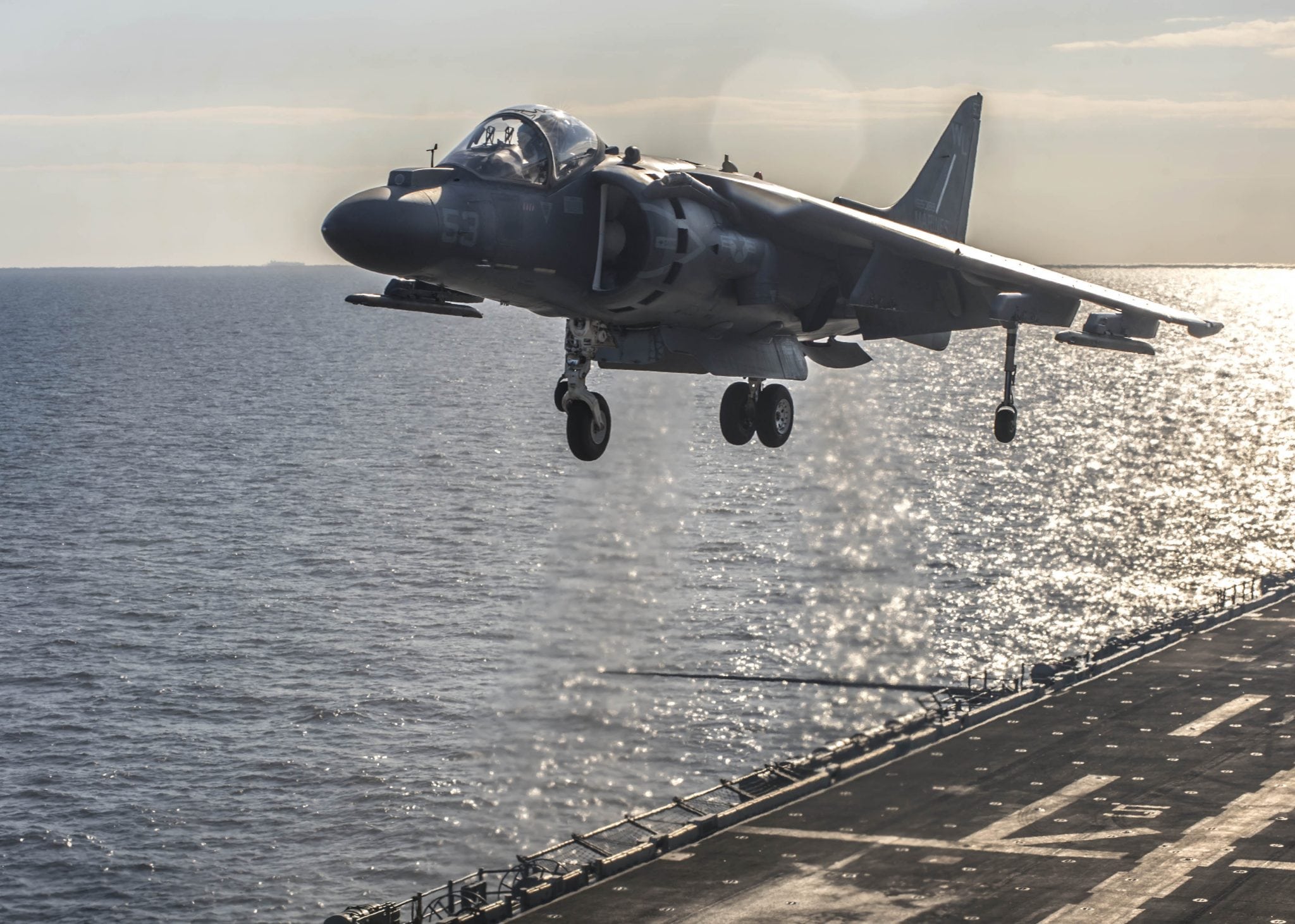[Avionics Today 01-20-2016] The U.S. Naval Air Systems Command (NAVAIR) is continuing to expand the integration of the Future Air Capability Environment (FACE) avionics standard across its aircraft system. Most recently, Rockwell Collins obtained a contract to provide a FACE-based Flight Management System (FMS) for NAVAIR aircraft. NAVAIR is also currently using the third FACE software release developed by General Dynamics for the mission computers featured on its fleet of AV-8B Harrier II aircraft.

An AV-8B Harrier, from the “Greyhawks” of Marine Medium-lift Tiltrotor Squadron (VMM) 161 (Reinforced), lands backwards on the flight deck of Wasp-class amphibious assault ship USS Essex (LHD 2). Photo: NAVAIR.
The FACE technical standard was originally developed by the Open Group’s FACE Consortium, a government-industry group formed in 2010 to establish an open architecture avionics environment for military aircraft. In recent years, major aerospace and defense companies have introduced onboard technology aligned to the FACE standard in an effort to lower the cost of supporting the portability and reuse of software components.
“We invest in the development of FACE standards by participating in the consortium, testing them in our labs and through contracted efforts with U.S. Naval Air Systems Command where we feed back lessons learned from the practical application of the standards,” Carlo Zaffanella, vice president of General Dynamics Mission Systems told Avionics Magazine. “An example is our contract for an upgrade to the AV-8B Harrier II Mission System Computer (MSC) where we are now delivering our third FACE software release.”
General Dynamics first received the contract to upgrade the AV-8B’s mission computers with FACE capability in 2013. Historically, the development of new software applications for airborne mission computers has been slow and expensive with a tight coupling between the applications and the hardware for which they were designed, according to Zaffanella. Interfaces have always been unique with limited reuse, but now that is changing.
“Adopting the FACE concept makes the process much more analogous to adding apps to a smartphone, where it is easy to add and subtract a given app without perturbing the others, and where it is possible to easily reuse apps across multiple platforms,” said Zaffanella. “Applying this example of software standards and tools to the work we are doing for the Marine Corps, the software aligned with the FACE technical standard, residing in our MSC to provide a common software baseline or core. When we receive a new or updated requirement from our customer, we can efficiently and cost-effectively create, test and deploy it to help the Marines carry out their global mission.”
Under the FACE development environment, military aircraft systems developers and manufacturers have direct access to Department of Defense (DOD) units, allowing them to work together and produce open standards that influence procurement, avionics and aircraft systems portability and reuse.
“Here is an example of how it is faster and less expensive. The T-45 Goshawk training jet, AV-8B Harrier II and the F/A-18 SuperHornet were all built by Boeing St. Louis and have the same basic avionics architecture. Bring FACE interfaces into their mission computers and you can quickly build new capabilities that can be shared among them. In other words, build it once and reuse it in three very different aircraft platforms,” said Zaffanella.
Transitioning the Harrier II and other military aircraft to FACE-based platforms and architectures should continue to prove to be useful going forward for the U.S. and its military partners. According to NAVAIR Col. Frederick G. Schenk, the AV-8B Weapon Systems Program Office (PMA-257) program manager, the Harrier II is scheduled to be in service through 2026 to meet U.S. Marine Corps (USMC) operational commitments to transition to the F-35B.
“One of the mission processors within the Harrier’s mission computer will host a FACE environment, which will allow the Harrier fleet to accept FACE-conformant software capabilities in the future. A FACE environment will allow software integrators to choose from a marketplace of reusable source code packages that could be viewed as similar to a smartphone market,” Schenk told Avionics Magazine.
In some cases, application source codes might need modification to fit individual user and platform requirements as the download and installation process will not be the same for each platform. Integration and testing will be necessary as well for safety and security purposes.
One area where NAVAIR is now expanding its adoption of FACE is for FMS that feature Required Navigation Performance and Area Navigation (RNP-RNAV) capabilities.
“Since FACE conformant RNP/RNAV capabilities have not been made available to the marketplace yet, re-hosting the F-18 RNP/RNAV solution on the Harrier II was deemed more cost effective and presented less risk than developing a new FACE Conformant RNP/RNAV solution for the AV-8B. This decision does not limit the Harrier II’s ability to integrate FACE Conformant software capabilities in the future,” said Schenk.